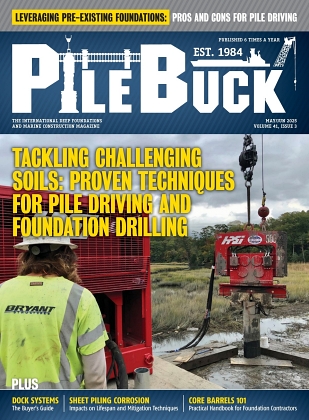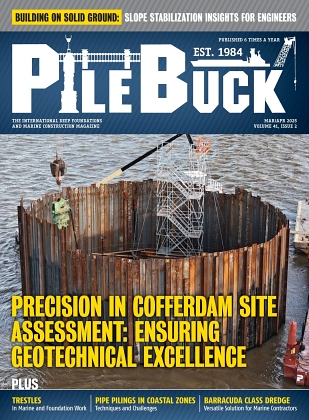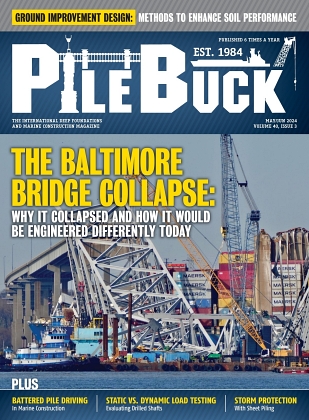INTERVIEW: JET Filter System – Maintainable Weep Hole Filters


View the complete interview here.
Pile Buck’s interview with David Heilman, CEO of JET Filter System.
PB: What is the purpose of the JET Filter System?
JF:
- All earth-retaining structures require a way to drain hydrostatic pressure off the back of a wall and provide soil filtration that will stop soil fines from leaching out through the drainage system.
- Drainage systems should provide two functions. They give water the easiest path to flow from behind a wall, and they provide soil filtration, so soil particles are not carried along with the water as it flows out from behind the wall.
- Traditional drainage systems are buried behind the wall and under the backfill material. Over time, the performance of traditional drainage systems will decrease, and eventually, they become clogged and fail. When clogged, the water stacks up behind the wall and puts pressure against the wall. The water will force itself out by creating new drainage paths. This will cause damage to the wall and create voids in the soil as particles are flushed out.
- JET Filter System provides maintainable weep hole filters, an innovative new drainage and soil filtration system for relieving hydrostatic pressure from behind earth-retaining structures. Maintainable weep hole filters replace or complement traditional drainage systems.
JF: Eventually, all drainage systems fail. Since traditional drainage systems are buried behind the wall, they are not accessible or maintainable. Excavation and reconstruction are required. This is costly and disruptive. Maintainable weep hole filters install from the front of any new or existing wall. They are not buried under the soil. This means they are accessible. Being accessible makes them available for inspection and cleaning at any time.
PB: How does a contractor or engineer know when a drainage system is necessary?
JF: All walls must have a drainage system; otherwise, water pressure will build up behind the wall until the wall fails. Contractors and engineers recognize the value of installing and maintaining drainage systems that can work at peak performance.
Engineers will specify the type of drainage system, which includes a geotextile fabric for soil filtration. Invented in the 1960s, geotextile fabrics are critical to prevent soil erosion. Since these clog over time, it’s better to have the geotextile accessible to be cleaned or replaced. JET Filter’s maintainable weep holes are the solution.
In existing walls, inspectors will spot signs of wall stress that put the wall at risk. Most often, the stress is caused by the buildup of hydrostatic pressure. Cost-effective solutions have never been available. So engineers, contractors, inspectors, and maintenance crews are enthusiastic to learn about JET Filter’s cost-effective and less disruptive solution.

PB: What applications are a JET Filter used for?
JF: JET Filter’s maintainable weep hole filters can be used in any earth-retaining wall. We have three groups of applications:
- Marine applications such as seawalls and bulkheads
- Transportation applications including bridge abutments, box culverts, roadway retaining walls
- Flood control applications, including drainage canals, dam spillways, and stormwater piping.
We also support landscape walls, retaining walls, even underground parking garages. Finally, we continue to work with engineers to develop new applications where our product can be used.
PB: A lot of our readers will be interested in applying JET Filters to their sheet pile systems. What types of sheet pile does a JET Filter work with, and how easy is it to install?
JF: Our products work with all types of sheet pile, for example, steel, vinyl, composite, and aluminum. Installation is simple. The product comes completely assembled, so you only have to core the right size hole, slide the unit in, and screw it to the wall. It takes less than 10 minutes.
PB: Regarding concrete seawalls, hypothetically, what would happen to the seawall if no drainage system were to be used?
JF: If there was no drainage system or the existing drainage system is failing, water would stack up (pile up) behind the wall. This means additional pressure is pushing against the wall. The added pressure can damage the wall causing it to crack, bow, bend, or move out of position.
At the same time, pressurized water will find a path around the drainage system. When this happens, soil particles will be carried along with the water, causing voids and sinkholes to develop behind the wall. Sinkholes are bad news for infrastructure supported by the retaining structure.

PB: And how about wooden bulkheads? Considering that wood is not as durable as concrete and steel, I would assume JET Filters would be essential?
JF: JET Filter’s maintainable weep hole filters work great on wooden bulkheads and other wooden retaining walls. It is very important to have good drainage on wooden structures. Otherwise, water pressure will force itself between the wood beams carrying backfile soil with it. Installing JET Filters will allow an easier escape path for the water.
PB: What equipment is needed to install a JET Filter?
JF: A core drill is typically used on all structures. The size of the bit should correspond to the size of the unit. For example, a 3” unit requires a 3” bit. Some steel sheet pile contractors prefer to use a plasma torch to cut the hole. This method is fine as long as the holes end up the right size. Other tools are basically standard toolbox items, like a wrench, tape measure, and marker.
PB: How does a JET Filter user know which size to use?
JF: Every retaining wall installation is unique. This includes wall characteristics such as height, local hydrology, such as rain events, and site soil conditions. For most applications, our 3” and 4” units are great options. We take the time to walk our customers through their application and our products to help them choose the best sizing.
PB: How many JET Filters are needed?
JF: Again, every retaining wall has unique properties. Performance tests have shown that when the 4” open-end unit is spaced 5’ apart, there is zero pressure at the weep hole and little pressure between the filters. This is with 4’ constant head pressure. Moving the filters apart increases the pressure between the units. At 10’ apart, water begins to stack up behind and in-line with the weep hole. And, further pressure builds up between the units. Without a detailed discussion, we would generally recommend that units are spaced 4’-6’ apart.

PB: What is the difference between “open-end” and “close-end” filters?
JF: When JET Filter first launched the products, all units were “open-end,” which means there is only a faceplate with slots for water to come out.
In 2016, the City of Fort Lauderdale updated its seawall ordinance so that no water could pass back through a drainage system, including weep holes. Working with the city, we launched our “closed-end” units. These units have a valve that stops wave action, storm surge, and high tides from flowing back through the weep hole into the surrounding ground.
PB: What are the JET Filters made of?
JF: Our units come preassembled and ready for installation. Our 3”, 4”, and 6” consist of an outer housing composed of 316L stainless steel or powder-coated A36 steel. The 316L is used in corrosive environments, which could be marine or soil-based.
Next, these units have an ABS cartridge, which holds the geotextile filter fabric. Our standard units come with Mirafi FW 300 woven geotextile. We have found that the FW300 provides a great balance between soil filtration, drainage, and maintenance. Customers can special order other woven fabrics, for example, Mirafi FW 700.
Each unit has a UV-protected, ABS faceplate, which protects and holds the cartridge. The ABS faceplate can come with the backflow preventer valve to become a “closed-end” unit.
Finally, our 2.5” option comes in UV protected ABS with the Mirafi FW300 woven fabric.

















